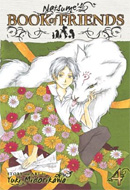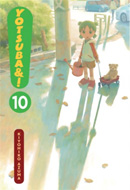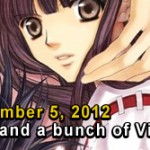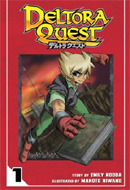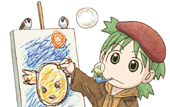Manga-ka: Yuki Midorikawa
Publisher: Viz Media
Rating: Teen (13+)
Release Date: July 2010
Synopsis: “Takashi is busy returning the names his grandmother trapped in her book and helping the local yokai with their problems. But he has to put his good deeds on hold when a black Nyanko Sensei snatches the Book of Friends! Takashi and the real Nyanko trail the bad cat to a secret yokai meeting deep in the forest. Will they be in time to stop the impostor’s wicked plans?!”
Bringing in a pleasant new addition to their Shojo Beat line of graphic novels, VIZ’s choice of Natsume’s Book of Friends has provided readers with yet another subtle manga treasure. A laid back adventure that slowly builds its mystery, the work presents itself in a gentle fashion while not shying away from contemplating darker story elements. Takashi Natsume’s world is both uncertain and hopeful, depicted in welcome shades of grey and light that make for a relaxing, involving reading experience.
Similar in themes to the darker Mushishi, Natsume’s Book of Friends depicts a world that is in some ways a fairy tale wonderland, yet also full of melancholy, loneliness and cruelty. The title itself mirrors this with it’s cheerful intonation, preparing you for a boy and his adventures, yet actually representing an item that causes him nothing but trouble. The book ends up making as many enemies as it does friends, a creation of his grandmother. Reiko is a fascinating figure, never appearing prominently in the story yet a constant presence despite her death. Well known among Yokai, his grandmother seems to have sealed herself away from not only the yokai through the ownership of their names, but also from people, leaving an orphaned Takashi to be passed among distant family members who don‘t seek any association with the deceased Reiko.
When invited to a convention for Yokai hunters, Takashi discovers that most Yokai hunters display little concern for their familiars, and comes to understand why Reiko had become wary of others with her power. Takashi is friendly to others, but wary of trusting them due to a childhood of being passed around and bullied. It’s a fascinating depiction of both the cruelty and potential within people, as Takashi slowly forms friendships with people and Yokai. It was also a fascinating choice that while the story doesn’t shy away from showing the more dangerous nature of Yokai, it also opts to give them personalities and roles as protagonists. It manages to also depict them sympathetically, whether as immortals who get tied up in the lives of ordinary, rapidly ageing humans or creatures caught and used as tools by some exorcists, or as equals with a place in the world and their own agendas.
Despite all this, Takashi remains an optimistic figure. While like many a young adult literature protagonist, he is an orphan, Midorikawa still provides Takashi with a family. His adoptive mother and father are depicted as kind people, and Mrs. Fujiwara is an ideal mother, constantly present yet respecting Takashi’s space, seemingly unaware of his activities with Yokai, and seeing Nyanko-sensei as nothing more then a normal cat, dubbing him Mr. Kitty. This aspect of the series shines best in the final chapter, as Takashi looks after a yokai egg and does his best to give to the egg what his adoptive parents have given to him- a family and home that accept you openly and embrace your good and bad sides. It was a pleasant surprise to see this focus given how often parental figures are discarded or ignored in manga, giving the fantasy elements a sense of firmness by binding them to daily family life.
Midorikawa’s artwork tends towards delicate lines without getting overly pretty, her character design looking like something that wouldn’t entirely look out of place in a seinen magazine. There are still uses of the usual shojo techniques, but it’s kept minimal, with adults who don’t look like slightly taller teenagers, sporting visible lines in their faces. Her monsters take on oddball appearances, often sporting masks to hide their forms as much as their hide their names. In terms of the main cast of Yokai, Takashi’s “pet” Nyanko is a delightful design choice, looking like a cross between the ceramic cats whose form he possesses within the story and Garfield, a round bossy creature that is somehow compellingly cute, even as he occasionally seems to be conspiring against his young master.
I’ve noticed VIZ has become more playful with the book design on their Shojo Beat titles lately. Crown of Love and Library Wars have more individual looks, lacking the usual white spine and pink Shojo Beat symbol most of the line sorts. Natsume’s look is in between the standard look and these more adventures takes on the line’s graphic design. While still sporting some of the line’s trade dress, Natsume uses it’s series logo on the spine, and the graphic designers opted to go for a weathered look, complimenting the series focus on Natsume’s grandmothers book. The textured green backdrop, and hand-made paper look of the cover’s logo’s off-white backdrop compliment the analogue colour cover artwork.
In terms of extras, Midorikawa opts for the usual shojo manga authors notes sprinkled through the volume, and like Natsumi Matsumoto, in those volume she focused on giving us a view into an artists like, in this case her first book signing. Giving a little bit of insight into her process, these tidbits are expanded upon further in the extra pages, which are also put to good use with notes in individual chapters. Given the introspective nature of the series, these prove useful, and elaborate on plot details, such as the focus on a romance between a human and a yokai in chapter ten. Apparently this aspect was editorially mandated as that chapter ran in the primary Lala magazine, but thanks to Midorikawa’s skill, it easily fits in with the more adventure-focused chapters. On top of these author-specific extras, VIZ included a short page of cultural notes, something I appreciate seeing. Yet they also manage not to go overboard, keeping it a brief page of topics, and ensuring to translate many items within the story, keeping the story coherent. A contemplative book like Natsume is better served by having translated sound effects, and no foot notes, ensuring you remain in its enchanting atmosphere.
I’d recommend the series highly to those who seek more oddball shojo series outside the normal fan favourites. While still very much so a young adult work, it expresses a deep sincerity and world-building elements that were appreciated, welcoming a larger audience. This is a series fans of contemplative titles rich in atmosphere such as Emma, Mushishi and Aria might find this series interesting, with strong attention to characters and setting.
(Note: In addition, those intrigued by the series may also want to check out the anime adaptation, streaming legally at Crunchyroll.com.)
Review written November 4, 2010 by Andre Paploo
Book provided by Viz Media for review purposes


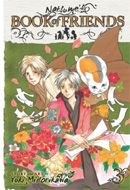


 Follow
Follow